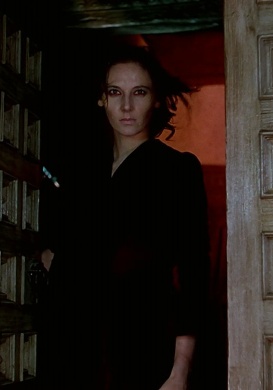We are in the far off dark land of post-war Canada, where a deaf-mute is assumed to be unable to think and feel by the primitives that live there. Enter Doctor Noble Dogoodery (Lew Ayres). He wanders about, doing good, until he meets virginal deaf-mute Belinda (Jane Wyman). She has never been taught anything in her life, nor been shown the slightest bit of love or affection. Naturally, she’s kind, obedient, slavishly hard-working, and too darn lovable for words. She learns lip reading and sign language in about twenty minutes once Doc Dogoodery starts to teach her due to sheer goodness. She’s also better than everyone else in every way, except the perfect doctor whom I’m sure would turn down his sainthood due to humility. Having someone not treat her like a horse causes her to smile, and that gets the attention of Loudmouth the Rapey Sailor (Stephen McNally), who does his thing, leaving Belinda with child. After a brief period of pouting, she gets over the whole rape thing, as is done, and the film suggests it’s best not to go dwelling on it anyway. Doctor Dogoodery wants to marry Belinda as he has fallen into the platonic state that equates to love for him. But the primitives are going to get in the way because they assume Doctor Dogoodery, with his un-Godly medicine, must be the rapist and besides, Belinda isn’t conscious anyway. And Loudmouth has some evil to do yet as well. It all ends in a trial, because… Why not?
There’s no way for me to talk about this film seriously, though it certainly wants to be taken seriously. This is Oscar-bait in its truest form. Hey, aren’t disabled people inspirational? Isn’t getting over rape inspirational? Aren’t doctors who are saintly inspirational?
A controversial subject and inspiration is the first step to some shinny statues. Warner Bros added money and skill behind and in front of the camera, making a well shot and acted picture. Yes, this is a nicely produced movie. And it paid off with Oscar nominations: twelve of them. But then it lost all but Best Actress (come on, Wyman was playing a deaf-mute super-woman who gets raped, so she had to win) because in the end this is an unbearable film.
Where did it go so very wrong? Everything with the characterizations is a mess, but the problems came before anyone started acting. It’s the script. I can’t say if the play it is based on is horrid. My guess is only partially. I’m assuming it all fell apart due to the rape. The Production Code forbid rape (if it isn’t in a movie, no one will do it, right?), and this was the first time the subject could be acknowledged in a film—allowed because of the importance of bringing a deaf-mute character to the screen (Hollywood really loves disabilities). Since they were dealing with this never before whispered subject, everything else had to be simple. The rapist had to be evil personified. The doctor had to be goodness personified. And Belinda had to be purity personified. They couldn’t approach rape in a realistic fashion so they did…this. If they’d turned the sailor into an actual werewolf, the doctor into the Archangel Michael, and given Belinda a halo, it would have been more subtle than what they ended up with. These are not human characters.
If it was more exploitative, or made with less skill, or maybe a cartoon, it would be more watchable, but then it would never had gotten away with its subject matter (of course anything unsavory happens off screen). There have been worse films nominated for Best Picture, but I can’t think of one which is more torturous to sit through. This is the year of The Treasure of the Sierra Madre and it had to compete with this tripe. Well, they both lost to Laurence Olivier mutilating Hamlet.





 The Academy gave Black Narcissus the Oscars for cinematography and art direction (they’d have looked pretty silly if they hadn’t), but nothing more. It should have won for Brian Easdale’s other-worldly score. The climax was filmed to match the already composed music, and not the other way around. Similarly they ignored Deborah Kerr who should have won for Best Actress, but far worse, Kathleen Byron for Best Supporting Actress. Byron’s Sister Ruth is one of cinema’s greatest characters, and it is her, putting on red lipstick, escaping through the forest to a beat straight out of
The Academy gave Black Narcissus the Oscars for cinematography and art direction (they’d have looked pretty silly if they hadn’t), but nothing more. It should have won for Brian Easdale’s other-worldly score. The climax was filmed to match the already composed music, and not the other way around. Similarly they ignored Deborah Kerr who should have won for Best Actress, but far worse, Kathleen Byron for Best Supporting Actress. Byron’s Sister Ruth is one of cinema’s greatest characters, and it is her, putting on red lipstick, escaping through the forest to a beat straight out of 





